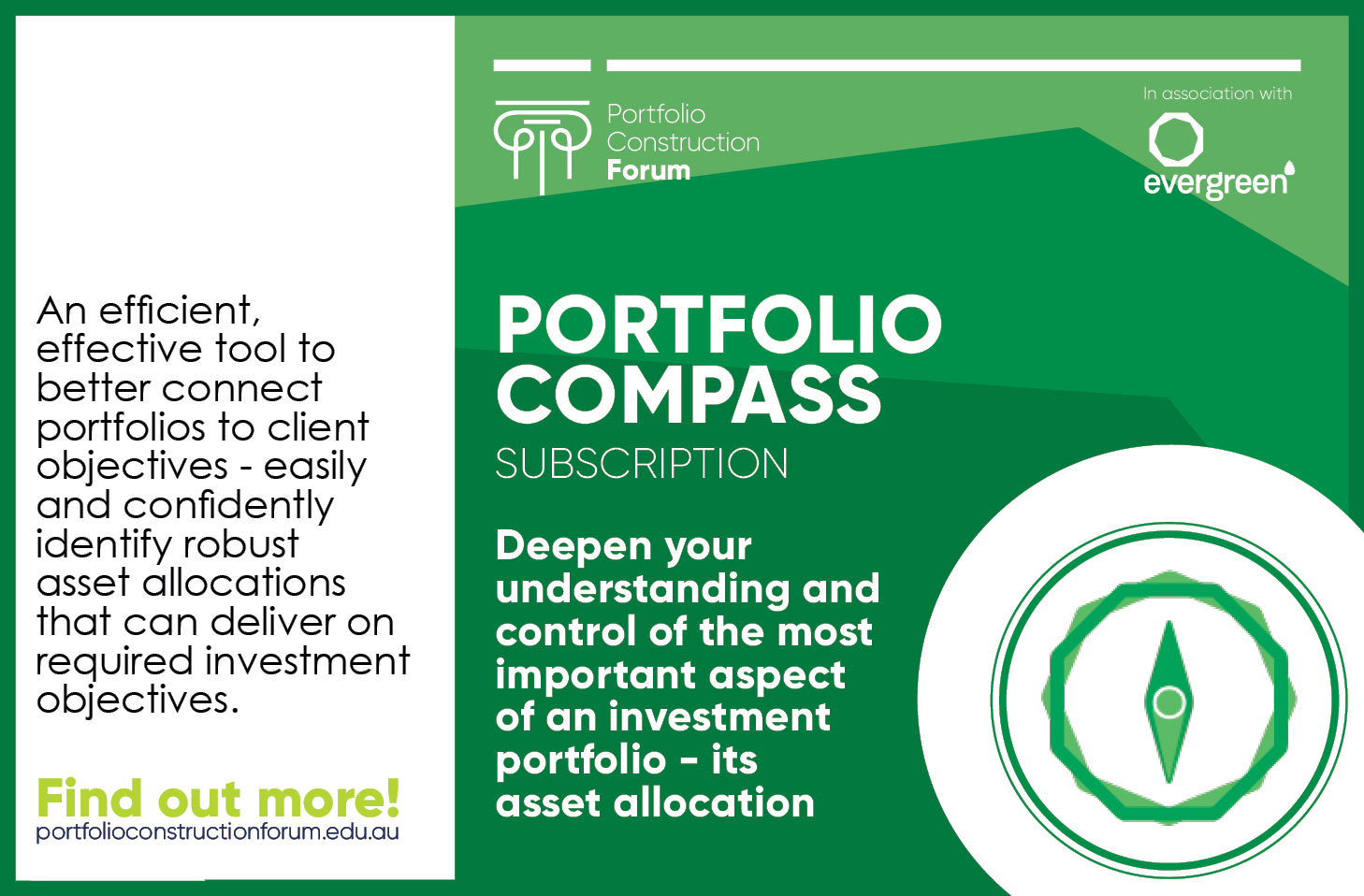Portfolio Construction Forum Strategies Summit
Debating portfolio construction strategies
Established in 2002, Strategies Summit is THE portfolio construction strategies conference of the year. Presented in Sydney each August, the face-to-face and online learning program features 50+ carefully selected leading investment thinkers - portfolio managers, CIOs, senior investment analyst, investment strategists, economists, research consultants and practitioners - from around the world, offering their best high conviction ideas on contemporary and emerging portfolio construction strategies.
It is a companion program to Markets Summit (February).
Strategies Summit will challenge and refresh your portfolio construction thinking by debating contemporary and emerging portfolio construction strategies, for you to consider applying in practice to build better quality portfolios.
Join us for Strategies Summit 2026, Wednesday & Thursday 19-20 August 2026, at our Live Studio in Sydney, as part of a group at a Live Site, or via Live Stream. Mark your diary! Meanwhile, watch the highlights and “attend” the sessions from past programs on demand.
Graham Rich
Dean, Portfolio Construction Forum
Quicklinks
Overview Where; Aim; Most suited to; CE/CPD
About the program Introduction; Knowledge Domain; Program structure
Past programs Watch the highlights and “attend” the sessions on demand
Overview
Where: Join us in our live studio, at an off-site live site, or via live stream
Strategies Summit is a full live “hybrid” program. Essentially, “hybrid” means flexible i.e. you choose how and where it best suits you to participate:
1. at our live studio in Sydney with 200+ peers
Attend the full program in person - mix and network face-to-face with Faculty and fellow delegates at our Live Studio at the University of New South Wales campus (Sydney).
2. as part of a group at an off-site live site with a group
Organise a group of your colleagues, or accept an invitation to join a group organised by one of our Faculty Partners, and attend the live broadcast together at an offsite location (e.g. boardroom or hotel meeting room). We have many groups do this around Australia and NZ and it works really well - you can enjoy the continuing education, camaraderie and networking without having to travel.
3. via live stream at your desk
This is a very popular option with many of our members (and the backup for any live studio or live site delegate who at the last minute has to isolate or deal with a personal emergency and can no longer attend in person).
4. on demand during and/or after the live program
As a registered delegate you get access to the on demand video within a few hours of each session being live streamed, so you can catch up anytime if you miss a session.
Aim: Debate portfolio construction strategies
Strategies Summit will challenge and refresh your portfolio construction thinking, as we debate contemporary and emerging portfolio construction strategies to help you build better quality investor portfolios.
Most suited to: Institutional and wholesale portfolio construction practitioners
Strategies Summit is relevant to all institutional and investment and wealth management practitioners who are involved in designing and implementing portfolios for investors.
It is essential for portfolio construction Practitioners, by whom we mean those whose primary role is involved in designing, building and/or advising on multi-asset, multi-manager managed portfolios, managed accounts and/or funds), using but not necessarily limited to managed funds from a range of firms, and who work in a financial advisory, fund research, investment consulting, family office, funds management, superannuation, private fund, endowment fund or investment platform business including:
- investment advisers giving investment advice on multi-manager, multi-asset portfolios, managed accounts and/or funds to individual investors;
- fund researchers;
- investment consultants consulting on multi-asset, multi-manager portfolios;
- portfolio managers designing, building and managing multi-manager portfolios; and/or,
- members of investment committees that oversee multi-asset, multi-manager portfolios, managed accounts and/or funds.
We also recognise and respect the invaluable role of Advocates and welcome them attending, too.
CE/CPD Accreditation: 12+ hours
By attending the program in full (at our live studio, a live site or via live stream), you will earn 12.00 CE hours that can be used to help meet the CE/CPD requirements of 20+ governing bodies (regulators, associations, and institutes) - including ASIC, APRA, Legislated (AU)/FAAA, FMA and CIMA® CE/CPD requirements, to name just a few.
After the live program, you can earn further CE hours by “attending” (online on-demand) the Special Interests Forum (elective) sessions you didn’t get to attend at the live program.
About the program
Introduction
Established in 2002, Strategies Summit has earned a reputation as THE portfolio construction strategies conference of the year. The program is designed and curated by our specialist, experienced and independent team and features an exceptional Faculty of 40+ leading investment thinkers - portfolio managers, CIOs, senior investment analysts, investment strategists, economists, independent consultants and practitioners - from around the world. Each offers his/her best, high conviction ideas around contemporary and emerging portfolio constructions issues and strategies, in the context of the program theme.
Knowledge Domain: Strategies
The Forum’s subject matter focus is on five Knowledge Domains – Philosophy, Markets, Strategies, Investing and Finology. As its name implies, Strategies Summit is focussed primarily on our “Strategies” knowledge domain.
Strategies - designing robust investment strategies to meet defined objectives
By applying a robust portfolio construction philosophy and in-depth knowledge of the drivers of and outlook for investment markets, practitioners can design quality multi-asset, multi-manager investment portfolios - including setting objectives, asset allocation, currency management, risk management, selecting and blending specific investments, and analysing the resulting portfolios - capable of meeting investors’ long-term objectives, in both accumulation and decumulation.
Program structure
Like all our continuing education programs, Strategies Summit is an integrated learning program with preparation, participation and review.
Before - Prepare
To maximise learning, you are provided with pre-reading aimed at boosting your knowledge and getting you thinking about the issues to be addressed in the program. The preparation is assumed prior knowledge.
During - Participate
The two-day program is designed and curated by our specialist, experienced and independent team. It is comprised of the 10-hour Critical Issues Forum (plenary) program and 2.5-hour Special Interests Forum (elective) program. In these, our Faculty of 40+ leading investment thinkers from around the world - portfolio managers, CIOs, senior investment analysts, investment strategists, economists, independent consultants and practitioners - offer their best high conviction ideas on contemporary and emerging portfolio construction issues and strategies, in the context of the program theme.
Strategies Summit is not just a talk-fest. You are challenged to decide whether you agree or disagree with each high conviction thesis presented, which ones you’ll investigate further, and which you’ll put into practice when building investor portfolios.
After - Review
After the live program, your learning continues. Videos of all presentations are available within a few hours of them live streaming for delegates to view on-demand. The full microsite for each session - a page per presentation featuring sync’d video and slides, podcast, presentation slides and paper(s) and CE accreditation - are available within four weeks. So you can revisit the sessions you attended, “attend” the SIF sessions you didn’t catch at the live program (and earn further CE hours), and review your key takeouts and implications to determine actions to take to build better quality investor portfolios.
Past programs - highlights and sessions

Strategies Summit 2025 - Time to make a move?
For much of the past four decades, the key to investing success was to stay long (and get longer!) risk assets. Crises became buying opportunities, as investors learned that western policymakers would go to almost any lengths to rescue financial markets. Even in the changed environment of 2020-2024, going with the flow was a good strategy most of the time.
But is that still the case? Central banks and politicians are constrained in their ability to support asset prices, globalisation continues to reverse, trade wars (and actual wars - cold and hot) are intensifying. A toxic brew of low growth and sticky inflation threatens economies, markets and asset prices. It’s crunch time for multi-asset, multi-manager portfolio design. Are the portfolio construction strategies that have served us well in the past still appropriate? Time to make a move?
Key takeouts | Attend on demand

Strategies Summit 2024 - The whole is greater than the sum of its parts!
For centuries, philosophers and scientists have explored emergence – the idea that several substances may be combined to create higher-level substances with new and very different characteristics. For example, metals, plastics, and glass form the components needed to build an airliner, offering a cost-effective and comfortable means of long-distance travel. Processed differently, those same raw materials combine to form laptop computers that enable people to communicate, trade and work remotely, reducing the need to travel at all.
Multi-asset, multi-manager investment portfolios can be viewed as complex machines that, if properly assembled and managed, provide benefits far outweighing those of their individual components. Each element should be best practice – yet only a holistic portfolio construction approach which considers all the parts, and the interactions between them, supported by a clear and cohesive implementation framework, can ensure client objectives will be met. The whole is definitely greater than the sum of its parts!
Key takeouts | Attend on demand

Strategies Conference 2023 - You can do anything, just not everything!
Today, as practitioners continue to navigate the structural shift to an inflationary, higher interest rate investment regime in a volatile, uncertain, complex and ambiguous world, it stands to reason that portfolio strategies must continue to evolve from what worked in the prior “lower for longer” regime. We must think through which portfolio construction strategies remain fit for purpose, which are no longer appropriate, and which new strategies should be adopted.
But, common wisdom also warns us against throwing the baby out with the bathwater. Prioritising the most important changes to make to investment objectives, asset allocation, currency management, manager selection and blending, and risk management is key – because you can do anything, just not everything!
Key takeouts | Attend on demand

Strategies Conference 2022 - The future ain’t what it used to be!
Rarely, a crisis – or combination of crises – heralds a sea-change in global affairs. Such regime shifts reverberate through societies and economies. Back in 2020, Strategies Conference explored the idea that we were entering “a whole new world” due to Covid-19, and debated what that meant for building quality investor portfolios. At the time, not everyone agreed that it was a whole new world. Two years on, more major crises have unfolded, and the new global regime is coming into sharper focus. Times have changed! Constructing quality multi-asset, multi-manager portfolios capable of meeting client goals in the years ahead is going to be more challenging than over the past 30 years.
Key takeouts - Macro matters! | Attend on demand
Key takeouts - Asset allocation matters! (22 mins)

Strategies Conference 2021 - The end justifies the means!
Portfolio construction is only “successful” when it helps clients achieve their financial goals. Yet delivering on those goals - be it financial independence or, at the very least, a reasonable standard of living in retirement - is more challenging than ever. The vast fiscal and monetary responses to Covid-19 helped stabilise economies and boost asset prices, but did little to aid long-term investors - arguably, they have undermined the prospects for long-term investment portfolios. We find ourselves in an environment of historically high asset prices and heightened uncertainty about the path of inflation and the pandemic itself - while also grappling with complexities that pre-date the crisis, including ultra-low interest rates, technological disruption, and geopolitical tension which increase market risk further. We need to be open-minded to contemporary, emerging and non-traditional portfolio construction theories, techniques and tools, to maximise the likelihood of meeting client goals in the years ahead. The end justifies the means!
Key takeouts | Attend on demand

Strategies Conference 2020 - It’s a whole new world!
Great eyesight depends on more than just clarity of vision - peripheral awareness, eye co-ordination, depth perception, focus and colour sensitivity all play a crucial role, without which our vision is impaired. Strategies Conference 2019 looks ahead at the issues that will dominate the 2020s and beyond to provide greater clarity in building quality portfolios.
Key takeouts | Attend on demand

Strategies Conference 2019 - 20/20 vision
To design and build quality portfolios capable of meeting the long-term objectives of investors, practitioners need clear vision across a range of issues - setting objectives, asset allocation, portfolio risk and currency management, selecting and blending specific investments, and analysing the resulting portfolio. Of course, hindsight has the benefit of being 20/20 vision, so we can look back with clarity on the past decade and the portfolio construction lessons learned. But more importantly, we need clear foresight of the forces which will influence portfolios in the 2020s and beyond.
Overview (17 mins) | Attend on demand

Strategies Conference 2018 - Future proof portfolios?
Investment portfolio construction is, by definition, an exercise in long-term thinking. By creating strategies that blend asset classes to achieve future returns, practitioners seek to meet the distant future financial needs of individuals. Yet the process is fraught with difficulty due to the inherently uncertain nature of financial markets, powerful secular and structural developments, and clients’ desires to be both certain of meeting their investment goals while avoiding any sting on the downside during the journey. Given these uncertainties and competing priorities, are future-proof portfolios achievable?
Key takeouts | Attend on demand

Strategies Conference 2017 - It all adds up!
An exceptional tapestry is far more than just the sum of its individual threads, and a masterpiece painting is far more than just the sum of its brush strokes. So too is an investment portfolio far more than just the sum of the many individual investment decisions and strategies that must be made and woven together, based on investment beliefs. And, unlike the past 35 years when equity and bond prices were boosted by declining inflation and interest rates, and rising corporate profitability, in today’s lower return, increased risk environment, practitioners must take even greater care that every investment decision contributes positively to a portfolio meeting its objectives. Every little bit counts.

Strategies Conference 2016 - The long and short of it!
Investing is supposed to be about the incremental replacement of human capital with financial capital over the long term - that’s the theory. But today’s environment and our behavioural biases conspire against such a pure case. In short - short-termism seems rife! We see the effect in the ever increasing emphasis on fees and reporting of short-term returns for markets, securities, funds and portfolios. Is the concept of long-term investing increasingly irrelevant?

Strategies Conference 2015 - Crossroads: Dilemmas | Decisions
Portfolio construction is approaching a crossroads – and critical questions must be answered. Complicating things further, what were only emerging megatrends early last decade have now become entrenched, causing massive structural change and further portfolio construction dilemmas. Critical decisions must now be made.

Strategies Conference 2014 - Reconnecting the three Rs - Risk & Return (& Relating)
The last decade has seen a distinct disconnect between investment risk and return, versus what we’re taught should be the case. How can we reconnect risk and return in portfolios? If that’s not difficult enough, how do we best communicate these complex concepts to investors, in a way they can understand?

Strategies Conference 2013 - Lifecycle Investing
Better quality portfolio construction must take a whole of life focus, considering accumulation and decumulation - and their profoundly complex mix of risks - as equally important phases of one continuous process. How do we better construct portfolios for the whole of an investor’s life?

Strategies Conference 2012 - tHiNkInG oUtSiDe ThE bOx
For the first time in generations, we’re in a new investment regime. Markets are likely to produce modest real returns with significant volatility for the next decade or more. Different (and difficult) times call for different approaches to portfolio construction. How do we build better quality investor portfolios in this new regime?

Strategies Conference 2011 - Thinking about the woods AND the trees
For a long time, practitioners could devote themselves to company financials and valuations, with ‘set and forget’ asset allocation models. But then along came the biggest macro economic shock in more than a generation - suddenly, macro mattered. What are the key macro AND micro issues - and what they mean for investor portfolios?
![]()
Strategies Conference 2010 - Building shock resistant portfolios
With sovereign uncertainty and global systemic risk at unprecedented levels and likely to remain so for much of the decade, markets are likely to be volatile for years, lurching from one shock to the next, with rallies between. So how do we build shock resistant portfolios?

Strategies Conference 2009 - Investing in the new reality
The 2009 Conference was the first post Global Financial Crisis. It was a very different investment environment compared to a year prior - some things had changed forever; others only temporarily. Some things had not changed at all. But which was which? What WAS the new reality? And what did it mean for portfolios?







